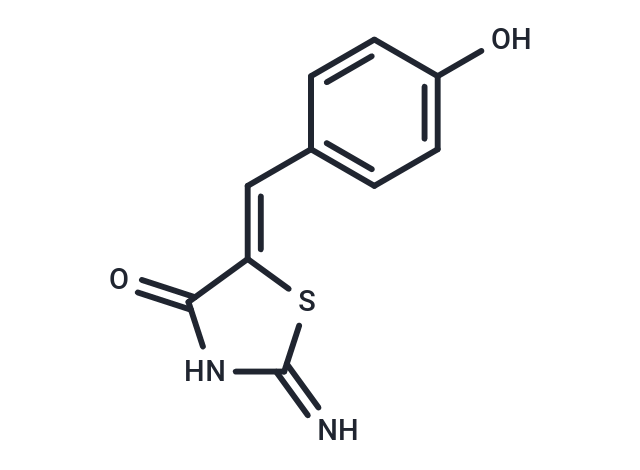Shopping Cart
- Remove All
 Your shopping cart is currently empty
Your shopping cart is currently empty

(Z)-Mirin is a potent Mre11–Rad50–Nbs1 (MRN) complex inhibitor, and inhibits Mre11-associated exonuclease activity.

| Pack Size | Price | Availability | Quantity |
|---|---|---|---|
| 5 mg | $50 | In Stock | |
| 10 mg | $79 | In Stock | |
| 25 mg | $143 | In Stock | |
| 50 mg | $238 | In Stock | |
| 100 mg | $438 | In Stock | |
| 200 mg | $571 | In Stock | |
| 500 mg | $917 | In Stock | |
| 1 mL x 10 mM (in DMSO) | $50 | In Stock |
| Description | (Z)-Mirin is a potent Mre11–Rad50–Nbs1 (MRN) complex inhibitor, and inhibits Mre11-associated exonuclease activity. |
| In vitro | Mirin inhibits DSB-induced ATM activation, the ATM-dependent phosphorylation of the downstream targets Nbs1 and Chk2 and the MRN-dependent autophosphorylation of ATM at Ser1981 in response to DSBs. Mirin also inhibits the G2 checkpoint in TOSA4 cells, and homology-dependent DNA repair in HEK293 cells. [1] In cells with integrated HPV16 (SiHa), Mirin sensitizes HPV episomes to PA25 resulting in a ~5-fold reduction of the PA25 IC50. [2] Pretreatment with mirin also decreases cell viability and inhibits proliferating cell nuclear antigen expression in cisplatin-treated human embryonic kidney 293 cells. [3] |
| Kinase Assay | Nuclease assay: Reactions with oligonucleotide nonhairpin substrates contains 25 mM MOPS (pH 7.0), 60 mM KCl, 0.2% Tween 20, 2 mM DTT, 1 mM or 5 MnCl2 (or 5 mM MgCl2, or 5 mM CaCl2), 0.1 pmol of DNA substrate, and 0.3 pmol of Mre11 (or an equivalent amount of Mre11 complexed with Rad50) in a volume of 10 μl, and are incubated at 37°C for 30 min. SDS, EDTA, and proteinase K are then added to final concentrations of 0.2%, 5 mM, and 0.1 mg/ml, respectively, and incubated for another 15 min. 4 μl of each reaction is mixed with 4 μl of formamide loading buffer, and then loaded onto a sequencing gel containing 10% acrylamide and 7 M urea. After the run, each gel is analyzed using a phosphorimaging system. Reactions containing hairpin substrates are identical to those with nonhairpin substrates except that 3 pmol of Mre11 is added to reactions as indicated, and the reactions are incubated at room temperature overnight. Nonhomologous end-joining reactions contains 25 mM MOPS (pH 7.0), 60 mM KCl, 0.2% Tween 20, 2 mM DTT, 4 mM MgCl2, 2 mM MnCl2, 0.5 mM ATP, 4 ng of plasmid DNA, 10% polyethylene glycol, 0.01 pmol of human DNA ligase I, and 0.06 pmol of Mre11 or 0.1 units of E. coli exonuclease III (GIBCO-BRL), in a volume of 10 μl. After incubation at 37°C for 25 min, Tween 20 is added to a final concentration of 0.5%, and a 2.5 μl aliquot is amplified by PCR using primers DAR5 and DAR147. PCR products are cloned using the TA cloning kit and sequenced using an automated ABI Capillary Genetic Analyzer. |
| Cell Research | Human embryonic kidney (HEK) 293 cells are maintained in RPMI-1640 supplemented with 5% heat-inactivated fetal bovine serum, penicillin (100 U/mL), and streptomycin (100 mg/mL) in humidified air with 5% CO2 at 37 °C. Cells are given fresh medium at 48 h intervals. The cells are seeded in 96-well plates in regular growth medium. Cells are pretreated with mirin (100 μM for 1 h before the cisplatin (20 μM) treatment followed by incubation for 8 and 24 h. The MTT assay is performed using the EZ-Cytox cell viability assay kit according to the manufacturer's protocol and MTT reduction is measured at a 450 nm wavelength using a micro-plate reader. (Only for Reference) |
| Alias | Mirin |
| Molecular Weight | 220.25 |
| Formula | C10H8N2O2S |
| Cas No. | 1198097-97-0 |
| Smiles | Oc1ccc(\C=C2/SC(=N)NC2=O)cc1 |
| Relative Density. | 1.49 g/cm3 (Predicted) |
| Storage | Powder: -20°C for 3 years | In solvent: -80°C for 1 year | Shipping with blue ice. | |||||||||||||||||||||||||||||||||||
| Solubility Information | DMSO: 75 mg/mL (340.52 mM), Sonication is recommended. | |||||||||||||||||||||||||||||||||||
Solution Preparation Table | ||||||||||||||||||||||||||||||||||||
DMSO
| ||||||||||||||||||||||||||||||||||||

Copyright © 2015-2025 TargetMol Chemicals Inc. All Rights Reserved.